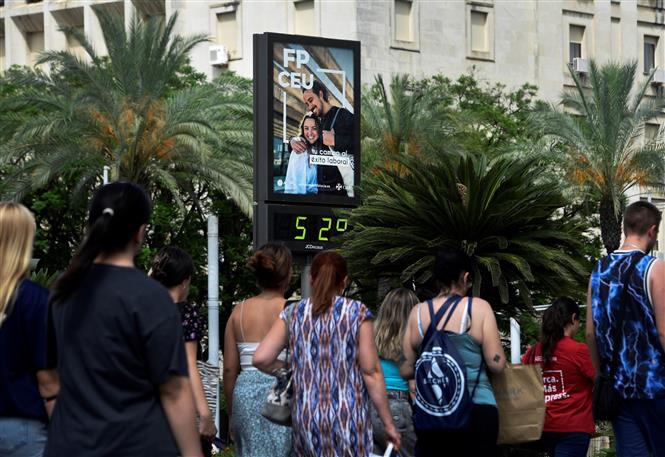The world has already experienced its hottest June and July on record, but while the peak of the El Nino climate pattern is not expected until November 2023 at the earliest, the “global warming era” has already begun.
 |
| A digital thermometer shows a temperature of 52 degrees Celsius in Seville, Spain on July 10, 2023. |
Scary reality
According to the European Union's (EU) climate change agency Copernicus Climate Change Service, the world's average temperature in June was 0.5 degrees Celsius higher than the 1991-2020 period, breaking the previous record set in June 2019 by a considerable margin. However, heat waves continued to rise. On July 3, the global average temperature was recorded at 17.01 degrees Celsius, surpassing the 17-degree mark for the first time since such data began being collected 44 years ago. The new record was broken the next day when the average global temperature reached 17.18 degrees Celsius and then broken again on July 6 when the average global temperature reached 17.23 degrees Celsius. And the latest data from Copernicus shows that the average temperature in the first 23 days of July reached 16.95 degrees Celsius, much higher than the previous record of 16.63 degrees Celsius, set in July 2019. In fact, many scientists believe that this will be the highest temperature our planet has experienced in at least 120,000 years.
Extreme heat is sweeping across continents, with devastating consequences. In Europe, successive heatwaves have scorched Italy and the rest of southern Europe, forcing those who can afford it to seek shelter in air-conditioned homes and offices or seaside retreats. But for many seniors, the heat is like a new COVID-19 pandemic, isolating them in air-conditioned rooms, prompting governments to impose a range of health protection measures for this group.
The intense heat this summer has also forced Greek authorities to close the famous Acropolis, evacuate tourists from the island of Rhodes due to heat-related wildfires, and forced tourists on the Italian island of Sardinia to stay indoors because of the risk of going out in the heat. Many tourists have opted to go to cooler places instead of the famous but scorching sun. This is considered a seismic change for Europe's travel and tourism industry, which contributed 1.9 trillion euros ($2.1 trillion) to the region's economy last year, and could change typical travel itineraries in ways that could be particularly damaging for some southern European countries, where the destination and length of vacations are determined by weather factors.
In the United States, more than 5,000 temperature records have been broken in the past 30 days. In Maricopa County, Arizona, the weather was so hot that people were rushed to the emergency room with severe, sometimes life-threatening burns. Sometimes the cause was simply falling on the hot pavement. Some hospitals were overwhelmed by the record heat.
In Asia, China's capital Beijing has experienced a record-breaking heat wave, while the Japan Meteorological Agency (JMA) recently warned of the risk of unprecedented high temperatures in a decade across the country from July 26 to August 3. Meanwhile, the Korea Meteorological Agency (KMA) announced that it would maintain a heat wave warning for most parts of the country as the number of deaths from heat-related causes increased sharply in the south and other regions over the weekend ending on July 30.
Warnings not to be missed
Speaking at a press conference at the United Nations headquarters in New York on July 27, UN Secretary-General António Guterres said the extreme heat is due to climate change and “it’s scary.” However, according to the head of the world’s largest multilateral organization, this is just the beginning. “The era of global warming is over, the era of global warming has arrived,” Mr. Guterres emphasized.
Previously, on July 21, in an interview with Reuters, the World Meteorological Organization (WMO)'s senior advisor on extreme heat, John Nairn, warned that extreme heat would occur more frequently and sporadically throughout all seasons. According to Nairn, global temperatures are increasingly increasing, causing heat waves to occur more frequently and with greater intensity. This is also the opinion of a group of international scientists from World Weather Attribution (an organization that specializes in assessing the role of climate change in extreme weather patterns around the world) on July 25. According to scientists, if the average global temperature increases by 2 degrees Celsius compared to pre-industrial times, prolonged extreme heat waves could occur every 2-5 years.
As for the cause, scientists at World Weather Attribution believe that El Nino may be the cause of the severe heat across North America, Europe and China, but the main factor is still the increase in greenhouse gas emissions. Scientists estimate that the increase in greenhouse gas emissions has increased temperatures in North America, Europe and China by 2 degrees Celsius, 2.5 degrees Celsius and 1 degree Celsius respectively.
The world joins hands to cool down the Earth
To cool down the Earth, there is currently only one solution: to reduce greenhouse gas emissions, the most direct of which is to reduce the use of fossil fuels. Because currently, fossil fuels still account for about 82% of energy supply, while research by the International Energy Agency (IEA) shows that the process of using energy creates greenhouse gas emissions with the largest proportion, about 60% of the annual global greenhouse gas emissions.
However, to reduce greenhouse gas emissions, the key is to combine actions between governments and individuals. In an interview with The Washington Post on July 29, Professor Suraje Dessai, who specializes in climate change adaptation at the University of Leeds (UK), said that countries around the world are not ready for climate change, including heat waves, rising sea levels, etc. Therefore, governments need to increase investment to make the whole society better prepared to deal with climate change. On an individual level, according to Professor Sonia I. Seneviratne of the Swiss Federal Institute of Technology in Zurich (ETH Zurich), the ability of individuals to reduce emissions may vary between regions. For example, people in the US may find it harder to live without a car than in many European countries. But regardless, action is needed on both sides. There are decisions to reduce greenhouse gas emissions made by individual people, but the majority of greenhouse gas emissions reduction is at the global level, through changes in regulations, changes in infrastructure…
(According to Baotintuc.vn)
Source link




















































![[Maritime News] More than 80% of global container shipping capacity is in the hands of MSC and major shipping alliances](https://vphoto.vietnam.vn/thumb/402x226/vietnam/resource/IMAGE/2025/7/16/6b4d586c984b4cbf8c5680352b9eaeb0)













































Comment (0)